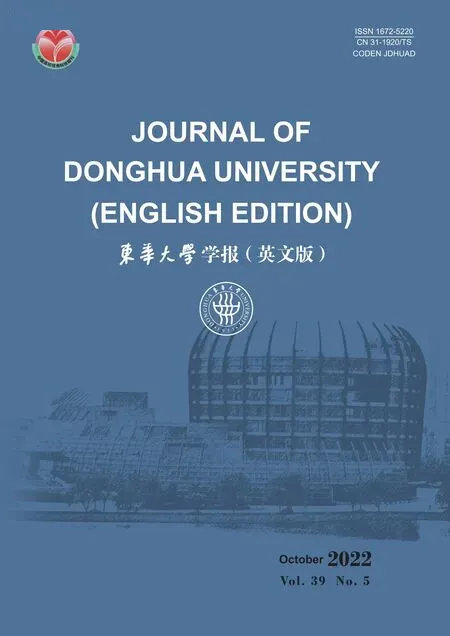Research Status and Development Direction of Smart Clothing Materials
2022-12-09LIXiaolei栗晓蕾SHANYufu单毓馥QIANXiaoming钱晓明SHIYunlong师云龙
LI Xiaolei(栗晓蕾), SHAN Yufu(单毓馥), QIAN Xiaoming(钱晓明), SHI Yunlong(师云龙)
College of Textile Science and Engineering, Tiangong University, Tianjin 300387, China
Abstract: With the continuous development of technology and society, smart devices have filled people’s lives and become an indispensable part of people’s lives. At the same time, smart clothing has also been greatly developed. This article introduces several smart clothing materials, analyzes the current research status of smart clothing materials, and further discusses the applications of smart clothing materials in military, medical, intelligent decoration, and sports and leisure fields. Then the problems of smart clothing in safety, environmental protection, and industrial technology are analyzed, and the corresponding solutions to these problems are proposed, so as to provide reference and guidance for the future development of smart clothing in China. And the research shows that smart clothing will develop in the direction of fashion and diversification, function and comfort, safety and environmental protection, convenience and low cost in the future.
Key words: smart clothing material; shape memory fiber; military application; waterproof and moisture permeability; microcapsule technology
Introduction
In recent years, the developed countries and regions have gradually abandoned rough processing of textile products, gradually reduced resource and energy consumption, environmental pollution pressure, low technological content, and low economic efficiency of the industry and products, and then utilized their own technological innovation to develop new materials to occupy the middle and high-end markets[1]. With the development of smart technology, smart clothing materials have been fully supported by software and technology. Smart clothing materials have integrated biochemical technology, electronic information technology, human-computer interaction technology, bionic technology and other technologies, gradually developed into a product of multi-field and multi-disciplinary research[2]. And with the continuous knowledge and understanding of smart clothing products, people’s demand for smart clothing products is also increasing.
Material is one of the three elements of clothing design, and it is the basis of clothing. The style and the color must be attached to clothing materials to display[3]. While the smart clothing materials meet the above basic characteristics, they also have special functions and properties. Smart clothing materials play an important role in the field of clothing.
As the integration of smart clothing materials and devices on clothing is still in the initial stage[4], there are few articles on the overview of smart clothing materials at present, and the induction of the application of smart clothing materials is not comprehensive. Therefore, starting with the basic concept of smart clothing materials, this paper introduces four kinds of smart clothing materials. Then the application of smart clothing materials in military, medical, intelligent decoration, and sports and leisure fields is discussed in detail. The existing problems of smart clothing materials are analyzed, and the corresponding solutions are put forward. Finally, according to the existing technology and the development trend, the suggestions and trends for the future development of smart textiles are put forward.
1 Research Status of Smart Clothing Materials
With the arrival of the intelligent era, smart clothing has become a new favorite in the field of textiles and clothing. Because smart clothing is still in its infancy in China, the main smart clothing materials are introduced and the application of smart clothing is summarized briefly.
1.1 Introduction of smart clothing materials
Smart clothing materials mean that the materials of clothing understand body language and follow the changes of human body and ambient temperature. That is, the smart materials have the functions of storage, transmission and transformation of energy and information[5]. Smart clothing materials often involve advanced technologies such as electronic information technology[6-8], bionic technology[9], and nanotechnology[10-12]. Smart clothing materials belong to smart materials, which are the natural products of integrating information technology into material science. Generally speaking, it is a new type of functional clothing material. Through the intellectualization of clothing materials, researchers have realized the wearing effect, comfort and applicability that ordinary clothing materials can’t achieve. Smart clothing materials are not a single materials, but an integrated system which is composed of multiple material system components through organic, close or strict scientific assembly[13].
Since the 1990s, smart clothing materials have gradually become the focus of attention in the world because of their outstanding practical uses and broad application fields. For example, the US, the UK, Finland and Japan have advanced research in this field. The more famous ones are outlast fibers developed by National Aeronautics and Space Administration (NASA) for the lunar landing plan and the thermosensitive discoloration material sway developed by Toray Company of Japan[6]. Most of these materials have been industrialized. China also pays more and more attention to the independent research and development of smart clothing materials. Tan[14]and Cao[15]studied and summarized smart clothing materials. Moreover, the research on smart clothing materials in China has been applied to military, medical, construction, textile and clothing and other fields, which shows that China has made a qualitative leap in smart clothing materials.
1.2 Main classification of smart clothing materials
1.2.1Color-changingfibermaterials
Generally speaking, the color-changing fiber is a fiber material that can change color. It means that it can sense and change the color of fiber materials under the influence of external environment, such as temperature and light. In essence, this kind of smart fiber material is applied to microcapsule technology. Specifically, the photosensitive or heat sensitive color-changing liquid crystal is completely wrapped with a film and added to the fiber. When following the changes of external temperature and light, the photosensitive or heat sensitive liquid crystal is stimulated or released by the outside, so that the fiber material can show different colors[16].
The Kanebo Company of Japan encapsulates the photochromic material that absorbs the ultraviolet light of 350-400 nm wavelength from colorless to light blue or dark blue in microcapsules to make a photochromic fabric[17]. Maoetal.[18]dispersed the color-changing fiber into the polymer to prepare a photochromic sheath-core fiber, which improved the strength of the color-changing fiber and overcame its fragility. At present, the dye pollution problem involved in the color-changing fiber has received widespread attention. The development of a color-changing fiber with strong color fastness, high stability and pollution-free is the main development direction in this field.
1.2.2Shapememoryfibermaterials
Shape memory fiber is a kind of fiber that can remember the initial shape given by the outside world after the first molding. The shaped fiber can be deformed arbitrarily, and the deformation can be fixed at a lower temperature (secondary molding), or it is a kind of fiber that fixes this deformation under the force of an external force[19]. Shape memory fiber can be divided into shape memory alloy fibers, shape memory polymer fibers and shape memory gel fibers.
Liuetal.[20]prepared graphene oxide(GO)/poly(Lactic-co-caprolactone)(PLCL) composite fibers by electrospinning GO and PLCL with shape memory properties, which enhanced its shape recovery force. MAOetal.[18]used shape memory fibers to weave medical compression stockings for the first time. They used semi-crystalline polyurethane to prepare polymer fibers and films by melt spinning, and compared their response modes at different stresses and temperatures. The results of the study found that the greater the stress and the higher the temperature, the stronger the stress memory performance of the material[21]. Although shape memory fibers have good deformation stability, they also have certain limitations. When some specific external forces occur, shape memory fibers cannot achieve complete non-destructive bending deformation and recovery.This is a major problem existing in shape memory fibers, and it will also be the focus of research in this field.
1.2.3Temperatureregulatingfibermaterials
Smart temperature regulating fiber, also called air-conditioning fiber, is a new type of functional product developed by combining phase change material technology with fiber manufacturing technology. It has a two-way temperature regulation effect[22]. The principle of temperature regulation is that the phase change material of the textile will undergo a solid-liquid reversible change according to the change of the external environment temperature. When the ambient temperature rises, it absorbs and stores heat, and the phase change material changes from solid to liquid; when the temperature decreases, phase change material releases the stored heat, which changes from liquid to solid, so as to realize the two-way temperature adjustment of textiles and create a comfortable temperature environment[23].
Wangetal.[24]developed a smart viscose fiber with intelligent temperature regulation and flame retardant function, which solved the flammability problem of viscose fiber. And this fiber can adjust the temperature when the ambient temperature changes, which maintains the microclimate stability between human body and clothing. Zhangetal.[25]prepared graphene modified intelligent temperature regulating fiber by the solution blending and wet spinning process. Through analysis and characterization, it was found that it had excellent functions in antibacterial and far-infrared temperature rise. Although smart temperature regulating textiles can improve the comfort of human body, there is instability and short temperature regulating time in the temperature regulating process.
1.2.4Waterproofandmoisturepermeablematerials
Waterproof and moisture permeable material is a kind of smart clothing material that can prevent the entry of outside water molecules and at the same time ensure the diffusion of human sweat to the outside world. This not only has the effect of waterproofing, but also makes the human body feel comfortable and not stuffy. Smart moisture regulating clothing is the representative of waterproof and moisture permeable smart clothing. Polyurethane intelligent membrane with humidity control function is a kind of intelligent humidity control membrane. The polyurethane intelligent membrane can adjust the humidity by changine the ratio of hard chain segment to soft chain segment of polyurethane resin in order to make it have an appropriate glass transition temperature[26]. When the temperature is higher than the glass transition temperature, the molecular Brownian motion in the material is larger, the molecular gap becomes larger, the water vapor molecules diffuse into the outside air through the molecular gap, and the moisture permeability increases, which is conducive to the discharge of human sweat. When the temperature is lower than the glass transition temperature, the molecular gap decreases rapidly and the moisture permeability decreases. Because the intelligent membrane has a non-porous structure, it has good water resistance.
Both of the smart waterproof and moisture permeable fabrics include Diaplex in Japan and Qualitex in the US[27]. At present, the problems that need to be solved urgently for waterproof and moisture-permeable fabrics are the sensitivity of materials to temperature sensitivity and the environmental protection of raw materials[28]. With the advancement of textile technology, the preparing ultra-fine or hollow fibers can be considered, the inorganic ions to treat the surface of the material can also be used to increase the specific surface area of can be considered the fabric and the photocatalysis or plasma treatment can also be considered to finish the fabric on one side to improve the moisture permeability.
1.3 Application of smart clothing materials
The development and application of smart clothing materials has become the mainstream of development in today’s clothing industry. The application of smart clothing materials has involved various fields, such as the military, medical, intelligent decoration, and sports and leisure fields, and it plays an irreplaceable position in various fields. It can not only meet the human pursuit of functionality, but also meet the needs of human beings for the comfort of clothing.
1.3.1Applicationinmilitaryfield
During the war years, smart clothing materials have been applied to military clothing. In the course of combat, in order that the soldiers can’t be found by the enemy, the color of soldiers’ clothes is required to be similar to the color of the local environment. For example, scientists have developed a “nano stealth military uniform”[14]. The so-called “nano stealth uniform” has four color deformation patterns. These patterns are simulated by computer after statistical analysis of a large number of jungle, desert, rock and other background environments[14]. The type, hue and brightness of its color, the reflection ability to the spectrum and the area distribution ratio of various colors are accurately calculated, so that the shape, hue and brightness of the spots on the “stealth coat” are consistent with the background. This study can make the clothes have the function of fake cover to avoid the attack of the enemy[29]. As shown in Fig. 1(copyright ©2022 Informa UK Limited), it is a thermochromic fabric, which is made of a color-changing bionic camouflage material by simulating a jungle pattern. Through temperature changes, the wearer can blend into the background like a “chameleon”[30]. Moreover, the temperature regulating fiber material is used to automatically adjust the temperature of military uniform, so that soldiers can adapt to the external temperature in cold or hot weather, and try to maintain the stability of body temperature, so as to improve combat effectiveness.
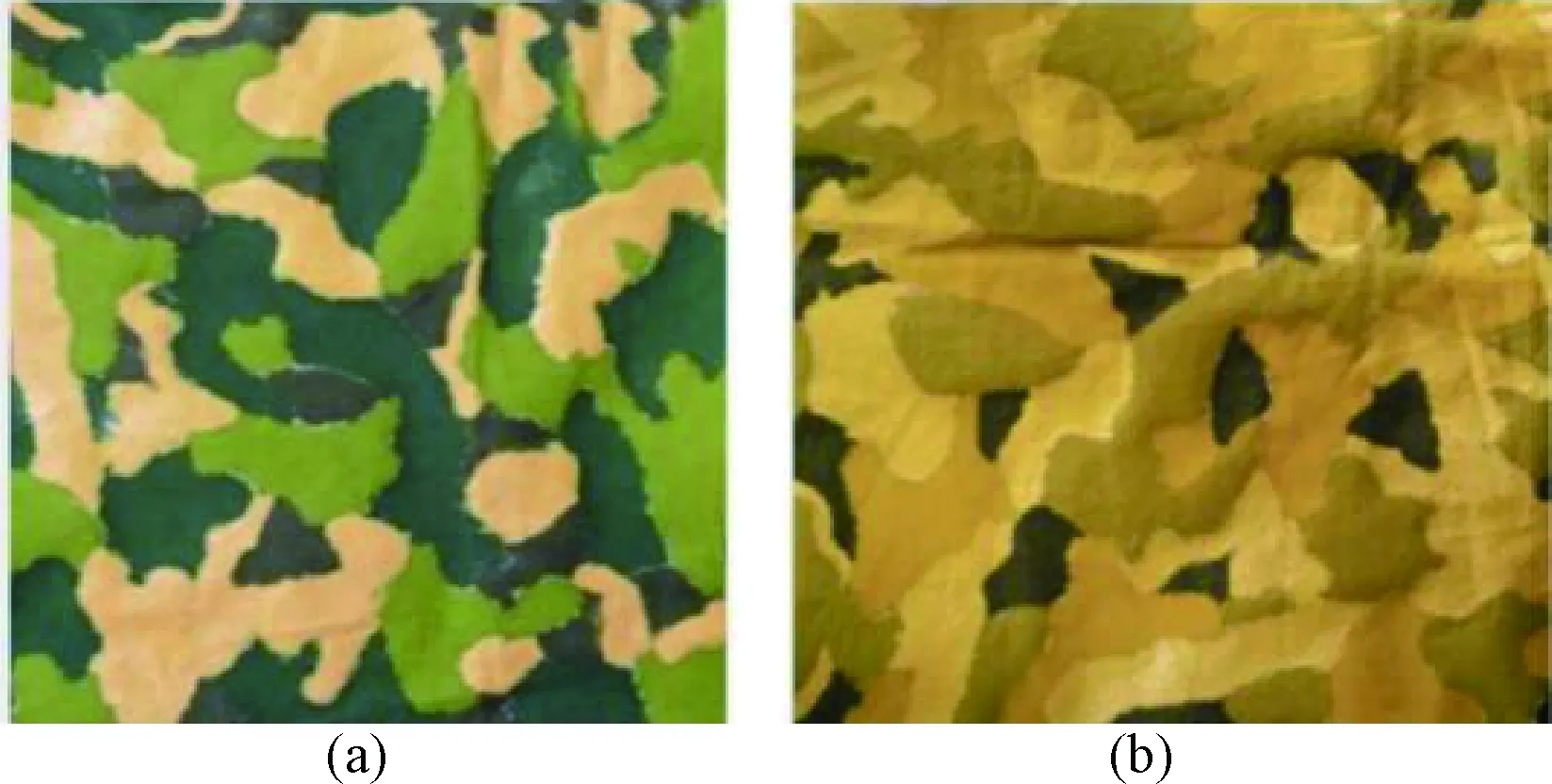
Fig. 1 Color-changing camouflage fabric: (a) before changing; (b) after changing
1.3.2Applicationinmedicalfield
Smart clothing materials have a wide range of applications in the medical field. On the one hand, they solved the problems of inconvenient movement and space occupied by bulky medical equipment. On the other hand, they solved the real-time monitoring of the patient’s physiological condition and improved the cure rate of the patient. For example, for the application of smart clothing materials in elderly medical care, the researchers have developed a “memory shirt”[31]. This “memory shirt” used silicon sensors in the shirt to monitor the behavior of the elderly in real time. When the elderly fall, it can use bluetooth technology to feed back information to the guardians at the first time, avoiding untimely treatment and other situations, and fully considering the influence of human body structure, clothing comfort and safety and other factors. This research product has a good application prospect in the field of medical applications for the elderly. Another kind of smart medical clothing is to weave insulating metal fibers and elastic yarns into the fabric structure. This fabric can receive the biological signals of the human body, and can transmit the stored information to the mobile phone and the computer in time, providing conditions for medical personnel to monitor the vital signs of the elderly in real time[32]. Through non-invasive real-time monitoring of the human body, it can prevent some common diseases of the elderly, such as high blood pressure, heart disease, diabetes and other chronic diseases, as shown in Fig. 2(copyright ©2022 Springer Nature Switzerland AG)[33]. This can greatly reduce the incidence rate of the elderly and improve the quality of life of the elderly.
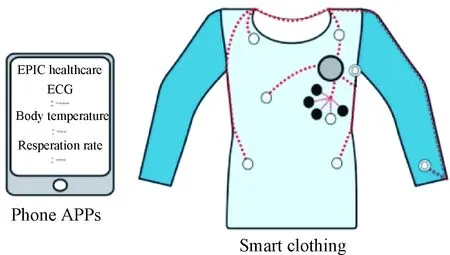
Fig. 2 Smart monitoring clothing
1.3.3Applicationinintelligentdecorationfield
The application of smart clothing materials in the field of decoration is mainly reflected in furniture decoration and clothing decorations. It uses the principle of microcapsule technology of color-changing fiber materials to wrap photosensitive or heat-sensitive liquid crystal with a film and add it to the fiber[34].When stimulated by changes in external light and temperature, the fabric will undergo various color changes. It can also be combined with intelligent sensors. A smart garment called Bubble can detect the wearer’s emotional changes through sensor. When the wearer shows emotional changes, smart clothing will show different colors[35]. This clothing can be applied to stage costumes and can show interesting effects, as shown in Fig.3(copyright © 2022 IOP Publishing). Smart clothing materials are mainly used in furniture such as curtains, chandeliers, bedspreads and other decorations. For example, photosensitive materials are applied to curtains.
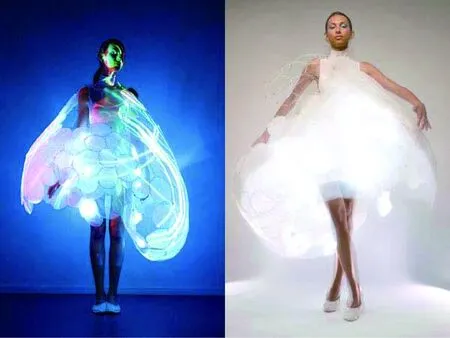
Fig. 3 Smart dance costume
With the change of external light intensity, smart curtains will automatically change their transmittance, so that indoor light lines can be maintained more stable, which provides a comfortable living environment for owners.
1.3.4Applicationinsportsandleisurefield
Smart clothing materials are also widely used in the field of sports and leisure. Installing equipment in smart sportswear can monitor the physical condition of athletes in real time, so as to improve exercise and let people better understand their bodies. As shown in Fig. 4(copyright © 2022 Spring Nature Switzerland AG), the wearer’s physical signs can be directly obtained through the mobile phone application. This intelligent system is also equipped with additional functions, which can push emotional interaction for users through health detection of their physical signs[33]. It can improve psychological problems as well as physical problems. Furthermore, Nike, one of the world’s largest shoe companies, has introduced the HyperAdapt 1.0 shoe, which is self-tying. The shoes have pressure sensors in the soles that detect when the foot is inserted and activate an algorithm that allows for automatic lacing[36]. This technology provides great convenience for the wearer.
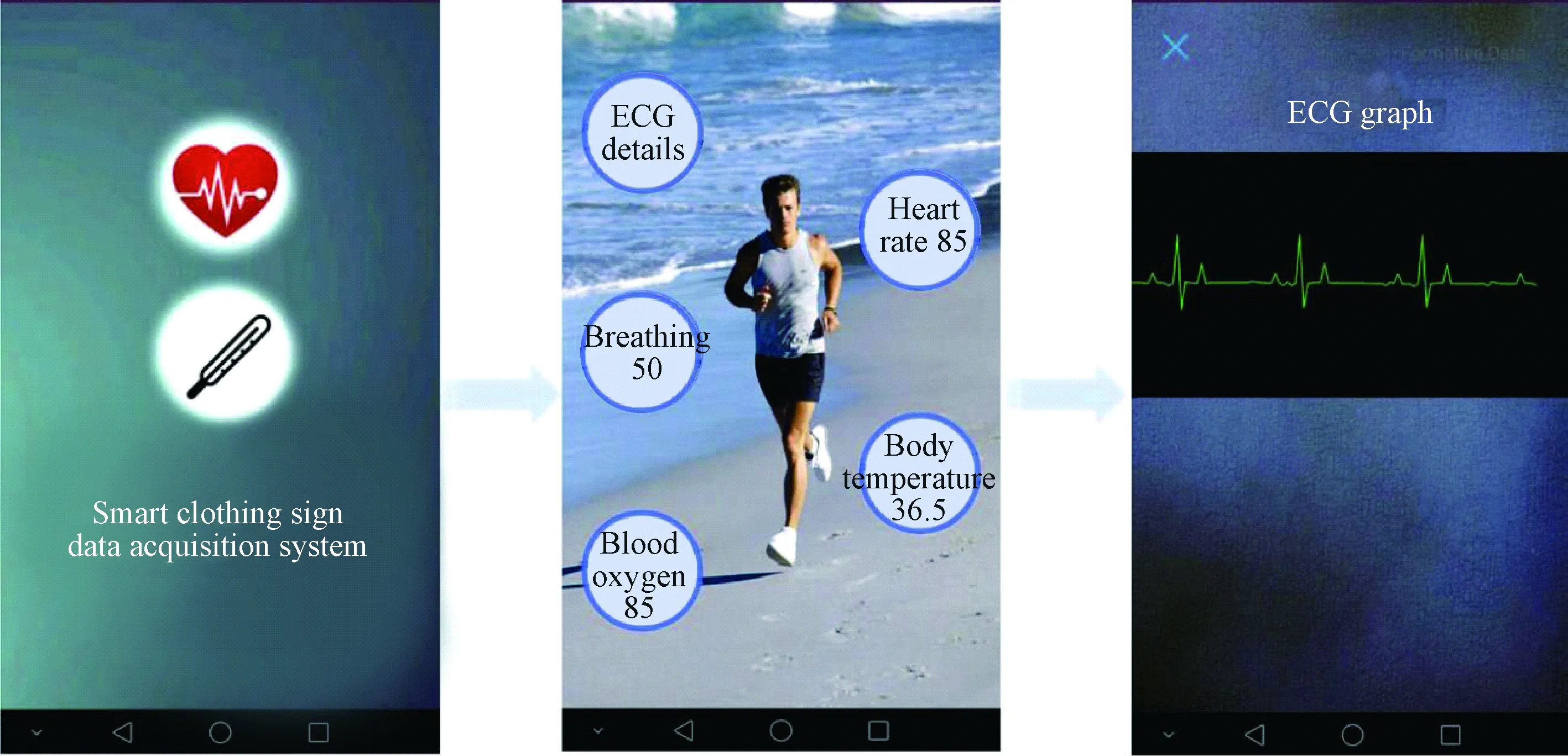
Fig. 4 Smart sportswear equipment
2 Main Problems and Solutions
In the application of smart clothing materials, although smart clothing materials is convenient for people’s life, it also exposes a series of problems.
2.1 Security problems
The application of smart clothing materials will cause some safety problems, mainly in the following aspects.
Firstly, the clothes made of conductive smart clothing materials may have the phenomenon of electric leakage, because at present, we still have insufficient ability or experience in the safety evaluation of smart clothing, which will easily lead to some potential safety hazards[37]. And, electronic smart clothing materials will also produce electric or magnetic radiation invisibly, which will cause certain harm to the human body when being worn. Secondly, by implanting some high-tech products into clothing materials, navigation and positioning may be formed, resulting in the leakage of personal information[38]. If this function is used by criminals, it will pose a certain threat to the personal health of others, make criminals master new illegal means, and cause great trouble to China’s safety management. Finally, the application of smart clothing materials may cause unnecessary troubles for the society, such as the application of “luminous clothing”, the light emitted by the luminous clothing on the highway may affect the driver’s line of sight and disrupt the traffic order.
2.2 Environmental protection problems
At present, people are paying more and more attention to the problems of environmental protection. Both in food and clothing, they are pursuing pure naturalness and pollution-free. The application of smart clothing materials is bound to cause certain pollution to the environment[39]. The problems are reflected in the entire process of processing, use and recycling. On the one hand, in the process, because our research and development technology are not completely systematic, resources cannot be well allocated and utilized. That is, a waste of resources is formed, which violates the principle of sustainable development[40]. On the other hand, after the smart clothing is used, some electronic components in the materials in the recycling process will cause certain pollution to the environment. At present, we are not able to solve this problem well.
2.3 Industrial technical problems
At present, although intelligence has become the current trend of the times, its application has not achieved popularization and widespread in our lives. The intelligent research technology has only demonstrated its effectiveness in certain fields, but our smart clothing research technology has not reached a very mature level. In other words, smart clothing materials are currently facing industrial technical problems. The workers in factory have not received professional training, their skills are not skilled enough, and their work efficiency is not high. Furthermore, the machinery and equipment used in industry are not perfect, workers cannot make good use of machinery to produce, and manpower is greater than material resources. Then, most of our management personnel who are skilled in processes and technologies have been put into production, so there is a lack of talents in management[41]. Therefore, we are still facing big problems in management and organization. These series of problems have led to the fact that smart clothing materials are not sufficiently systematic and perfect in terms of industrial technology.
2.4 Response solutions
By analyzing the problems of smart clothing materials in all aspects, we find that the most fundamental problem is that the research technology has not been solved. In view of the current technical bottleneck of smart clothing, we should actively explore new research methods, and create new industrial technology support.
Environmental protection is one of the most important issues today. While pursuing development in all fields and all aspects, environmental protection should be put first. Therefore, we should strengthen the design of smart clothing materials in terms of environmental protection, so that they can make full use of resources and avoid waste. In the process of recycling, we should strengthen the degradability of smart clothing materials to reduce environmental pollution.
We should strengthen the systematization of smart clothing production and train a large number of talents. It is also necessary to establish a set of strict standards, so that there is a basis and standards to refer to in the production and research process, so as to strengthen the safety of smart clothing.
3 Prospects of Smart Clothing Materials
Since the 1990 s, smart clothing materials have been developed at a very rapid rate at home and abroad. Although there are various problems in smart clothing materials, the overall trend is to develop in a good direction.
3.1 Fashion and diversified development
Initially, people’s pursuit of clothing is to satisfy their own wearability and comfort. With the improvement of living standards, people’s requirements for clothing are getting higher and higher. The fashion of clothing has become an indispensable part of designing clothing. Therefore, in the design of smart clothing, fashion elements will be considered[42]. The design of clothing colors, patterns, and clothing styles into smart clothing can capture consumers’ attention and meet the aesthetic requirements of the public[43]. At the same time, smart clothing will overcome the design concepts of traditional clothing, change the previous single production mode, and develop in the direction of diversification, intelligence and individualization. In the future, it will produce smart clothing that is in line with the trend of the times, simple and stylish, so that smart clothing can reach universal applications.
3.2 Functionality and comfort development
The so-called smart clothing is outstanding in its functionality. Its obvious advantage is that it has more intelligent functions than ordinary clothing. The future smart clothing will realize multi-functionality[44]. Comfort is the most basic requirement of consumers for clothing. Smart clothing materials will focus on its flow movement, emphasize relaxed shape and comfortable sense of movement, so that consumers’ bodies will not be bound, and realize the effect of fabric smoothness[45]. In the future, smart clothing will combine functionality and comfort. It can not only meet people’s requirements for clothing comfort, but also realize the functionality of clothing and realize a higher level of clothing fabrics.
3.3 Safety and environmental protection development
At present, most of the clothes we wear are dyed with chemical dyes, and many of the chemical components inside have carcinogenic effects and pose a certain hazard to the human body. Therefore, in terms of dyeing, the future smart clothing will use plant dyeing to dye the fabric. Such smart clothing is not harmful to our human body, and some plant dyes can be beneficial to human health, achieving the effect of safety and environmental protection.
For the recycling of smart clothing, the future smart clothing system will become more perfect, some electronic materials will be well handled, and a series of problems such as leakage and radiation[10]will be solved. And in the process of smart clothing recycling, all kinds of clothing materials will be standardized classified, which is conducive to the collection of managers and reduces the harm to staff to a certain extent.
3.4 Convenience and low-cost development
The future smart clothing has the function of folding and can be easily put into the storage bag. It is easy to carry during transportation, and the clothing will not be damaged and stained. In the future, the whole clothing packaging and transportation system will be more perfect, so as to realize the portability of smart clothing.
In terms of production cost, with the further study of researchers and staff, their technology will become more skilled, and the corresponding smart clothing materials will be effectively utilized, which reduces the problem of resource shortage and waste. And in the future, recyclable smart clothing will be developed. After reprocessing, many smart clothing materials can be reused, which greatly reduces the cost of smart clothing.
4 Conclusions
In general, the research and the development of smart clothing materials have made remarkable achievements, but the application of smart clothing materials has not been fully popularized in people’s lives. Smart clothing materials are mainly divided into four categories: color-changing fiber materials, shape memory fiber materials, temperature regulating fiber materials, and waterproof and moisture permeable fiber materials. By focusing on the application of the above smart fiber materials in the fields of military, medical, intelligent decoration and sports fields, we find that there are still hidden dangers and shortcomings in the application of smart clothing materials, which are reflected in safety, environmental protection and industrial technology. According to the existing problems, this paper puts forward corresponding solutions. The paper then proposes future development based on the current state and shortcomings of applications in these four areas. With the advent of the intelligent era, smart clothing materials will become the key research object in the field of textiles and clothing in the future. Under the environment of the continuous development of science and technology, smart clothing will continue to improve and develop towards diversification, so as to realize the universality of smart clothing.
猜你喜欢
杂志排行
Journal of Donghua University(English Edition)的其它文章
- Evaluation of Tactile Comfort of Underwear Fabrics
- Classification of Young Females’ Body Shape in Jiaodong Area Based on 3D Morphological Characteristics
- Property of Polyimide/Flame-Retardant Viscose Blended Fabrics
- Electromagnetic Transmission Characteristics of Y-Shaped and Y-Ring-Shaped Frequency Selective Fabrics
- Adaptive Neural Network Control for Euler-Lagrangian Systems with Uncertainties
- Adaptive Single Piecewise Interpolation Reproducing Kernel Method for Solving Fractional Partial Differential Equation
